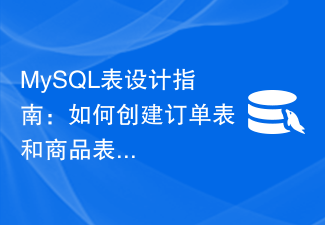MySQL Table Design Guide: Creating a Simple Employee Attendance Table
In enterprise management, employee attendance management is a crucial task. In order to accurately record and count employee attendance, we can use the MySQL database to create a simple employee attendance sheet. This article will guide you how to design and create this table, and provide corresponding code examples.
First, we need to determine the fields required for the employee attendance sheet. Generally speaking, employee attendance sheets need to contain at least the following fields: employee ID, date, work time, and off work time. In addition, in order to record and analyze attendance more comprehensively, we can also add other fields, such as overtime hours, leave time, etc. Here, we take the most basic fields as an example to explain.
Suppose we already have a table named "employees", which contains basic information of employees, including employee ID, name, etc. Now we want to create a new table named "attendance" to record employee attendance.
First, our SQL statement to create the attendance table is as follows:
CREATE TABLE attendance (
id INT PRIMARY KEY AUTO_INCREMENT,
employee_id INT,
date DATE,
start_time TIME,
end_time TIME
);In the above statement, we created a table named attendance and defined several fields, including id, employee_id, date, start_time and end_time. Among them, the id field is used as the primary key to uniquely identify each attendance record and is automatically incremented. The employee_id field is used to associate the employee ID in the employee table so that we can know which employee each attendance record belongs to. The date field is used to record the attendance date, and the start_time field and end_time field are used to record the work time and get off work time respectively.
Next, we can insert some test data into the attendance table to verify the correctness of the table. Suppose we have three employees with IDs 1001, 1002 and 1003. We can execute the following INSERT statement:
INSERT INTO attendance (employee_id, date, start_time, end_time)
VALUES
(1001, '2022-01-01', '09:00:00', '18:00:00'),
(1002, '2022-01-01', '09:30:00', '18:30:00'),
(1003, '2022-01-01', '10:00:00', '19:00:00');The above statement will create three attendance records, belonging to three different employees, with the date of 2022-01 -01, working hours are 9:00, 9:30 and 10:00, and off-duty hours are 18:00, 18:30 and 19:00.
Of course, the employee attendance sheet is not limited to these fields. We can also add other fields according to actual needs, such as overtime hours, leave time, etc. Here, we also provide you with an example. Suppose we want to add a field "overtime" to record overtime hours. We can modify the table structure through the following statement:
ALTER TABLE attendance ADD COLUMN overtime INT DEFAULT 0;
The above statement will add a field named overtime to the attendance table, with type INT and default value 0.
The above sample code demonstrates how to create a simple employee attendance sheet and insert test data. Based on actual needs, we can also add other fields and constraints to meet more complex attendance management needs. By using the MySQL table design guide, we can manage employee attendance more efficiently and improve the management efficiency of the enterprise.
I hope this article can provide you with help and inspiration in MySQL table design and employee attendance management. If you have any questions, please feel free to leave a message. Thanks!
The above is the detailed content of MySQL Table Design Guide: Create a Simple Employee Attendance Sheet. For more information, please follow other related articles on the PHP Chinese website!
 最简便的硬盘序列号查询方式Feb 26, 2024 pm 02:24 PM
最简便的硬盘序列号查询方式Feb 26, 2024 pm 02:24 PM硬盘序列号是硬盘的一个重要标识,通常用于唯一标识硬盘以及进行硬件识别。在某些情况下,我们可能需要查询硬盘序列号,比如在安装操作系统、查找正确设备驱动程序或进行硬盘维修等情况下。本文将介绍一些简单的方法,帮助大家查询硬盘序列号。方法一:使用Windows命令提示符打开命令提示符。在Windows系统中,按下Win+R键,输入"cmd"并按下回车键即可打开命
 如何通过PHP编写一个简单的在线预约系统Sep 26, 2023 pm 09:55 PM
如何通过PHP编写一个简单的在线预约系统Sep 26, 2023 pm 09:55 PM如何通过PHP编写一个简单的在线预约系统随着互联网的普及和用户对便利性的追求,在线预约系统越来越受到欢迎。无论是餐厅、医院、美容院还是其他服务行业,都可以通过一个简单的在线预约系统来提高效率并为用户提供更好的服务体验。本文将介绍如何使用PHP编写一个简单的在线预约系统,并提供具体的代码示例。创建数据库和表格首先,我们需要创建一个数据库来存储预约信息。在MyS
 如何使用Java编写一个简单的学生成绩报表生成器?Nov 03, 2023 pm 02:57 PM
如何使用Java编写一个简单的学生成绩报表生成器?Nov 03, 2023 pm 02:57 PM如何使用Java编写一个简单的学生成绩报表生成器?学生成绩报表生成器是一个可以帮助老师或教育者快速生成学生成绩报告的工具。本文将介绍如何使用Java编写一个简单的学生成绩报表生成器。首先,我们需要定义学生对象和学生成绩对象。学生对象包含学生的姓名、学号等基本信息,而学生成绩对象则包含学生的科目成绩和平均成绩等信息。以下是一个简单的学生对象的定义:public
 快速入门:使用Go语言函数实现简单的图书管理系统Jul 30, 2023 am 09:18 AM
快速入门:使用Go语言函数实现简单的图书管理系统Jul 30, 2023 am 09:18 AM快速入门:使用Go语言函数实现简单的图书管理系统引言:随着计算机科学领域的不断发展,软件应用的需求也越来越多样化。图书管理系统作为一种常见的管理工具,也成为很多图书馆、学校和企业必备的系统之一。在本文中,我们将使用Go语言函数来实现一个简单的图书管理系统。通过这个例子,读者可以学习到Go语言中函数的基本用法以及如何构建一个实用的程序。一、设计思路:我们首先来
 如何通过C++编写一个简单的音乐推荐系统?Nov 03, 2023 pm 06:45 PM
如何通过C++编写一个简单的音乐推荐系统?Nov 03, 2023 pm 06:45 PM如何通过C++编写一个简单的音乐推荐系统?引言:音乐推荐系统是现代信息技术的一个研究热点,它可以根据用户的音乐偏好和行为习惯,向用户推荐符合其口味的歌曲。本文将介绍如何使用C++编写一个简单的音乐推荐系统。一、收集用户数据首先,我们需要收集用户的音乐偏好数据。可以通过在线调查、问卷调查等方式来获得用户对不同类型音乐的喜好程度。将数据保存在一个文本文件或数据库
 如何使用PHP开发简单的文件管理功能Sep 20, 2023 pm 01:09 PM
如何使用PHP开发简单的文件管理功能Sep 20, 2023 pm 01:09 PM如何使用PHP开发简单的文件管理功能简介:文件管理功能在很多Web应用中都是必不可少的一部分。它允许用户上传、下载、删除和展示文件,为用户提供了便捷的文件管理方式。本文将介绍如何使用PHP开发一个简单的文件管理功能,并提供具体的代码示例。一、创建项目首先,我们需要创建一个基本的PHP项目。在项目目录下创建以下文件:index.php:主页面,用于显示上传表
 MySQL表设计指南:如何创建订单表和商品表Jul 02, 2023 pm 12:25 PM
MySQL表设计指南:如何创建订单表和商品表Jul 02, 2023 pm 12:25 PMMySQL表设计指南:如何创建订单表和商品表简介在数据库设计中,正确地创建表格是非常重要的。本文将重点介绍如何创建订单表和商品表,以提供一个指南供读者参考。同时,为了更好地理解,本文还会提供相关的代码示例。订单表设计订单表是用来存储订单信息的表。下面是一个简单的订单表设计示例:CREATETABLEorders(order_idINTPRIMARY
 如何使用PHP编写一个简单的网络爬虫Jun 14, 2023 am 08:21 AM
如何使用PHP编写一个简单的网络爬虫Jun 14, 2023 am 08:21 AM网络爬虫是一种自动化程序,能够自动访问网站并抓取其中的信息。这种技术在如今的互联网世界中越来越常见,被广泛应用于数据挖掘、搜索引擎、社交媒体分析等领域。如果你想了解如何使用PHP编写简单的网络爬虫,本文将会为你提供基本的指导和建议。首先,需要了解一些基本的概念和技术。爬取目标在编写爬虫之前,需要选择爬取的目标。这可以是一个特定的网站、一个特定的网页、或整个互


Hot AI Tools

Undresser.AI Undress
AI-powered app for creating realistic nude photos

AI Clothes Remover
Online AI tool for removing clothes from photos.

Undress AI Tool
Undress images for free

Clothoff.io
AI clothes remover

AI Hentai Generator
Generate AI Hentai for free.

Hot Article

Hot Tools

VSCode Windows 64-bit Download
A free and powerful IDE editor launched by Microsoft

SublimeText3 Mac version
God-level code editing software (SublimeText3)

Zend Studio 13.0.1
Powerful PHP integrated development environment

mPDF
mPDF is a PHP library that can generate PDF files from UTF-8 encoded HTML. The original author, Ian Back, wrote mPDF to output PDF files "on the fly" from his website and handle different languages. It is slower than original scripts like HTML2FPDF and produces larger files when using Unicode fonts, but supports CSS styles etc. and has a lot of enhancements. Supports almost all languages, including RTL (Arabic and Hebrew) and CJK (Chinese, Japanese and Korean). Supports nested block-level elements (such as P, DIV),

SAP NetWeaver Server Adapter for Eclipse
Integrate Eclipse with SAP NetWeaver application server.






